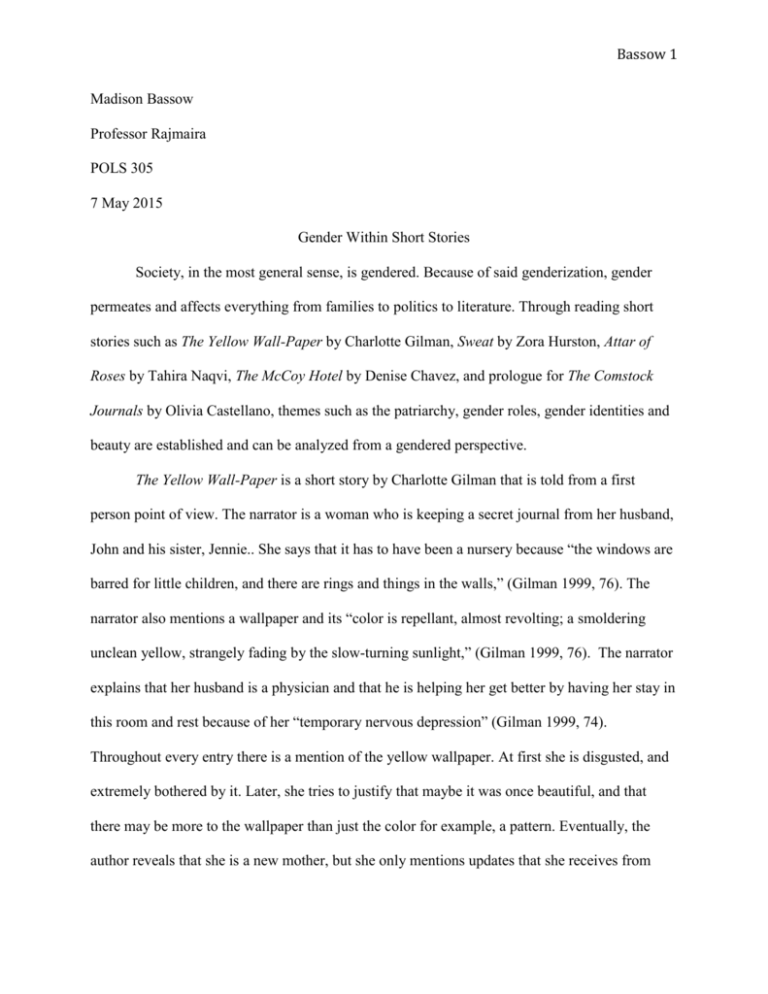Gender in Short Stories: Patriarchy & Identity Analysis
advertisement

Bassow 1 Madison Bassow Professor Rajmaira POLS 305 7 May 2015 Gender Within Short Stories Society, in the most general sense, is gendered. Because of said genderization, gender permeates and affects everything from families to politics to literature. Through reading short stories such as The Yellow Wall-Paper by Charlotte Gilman, Sweat by Zora Hurston, Attar of Roses by Tahira Naqvi, The McCoy Hotel by Denise Chavez, and prologue for The Comstock Journals by Olivia Castellano, themes such as the patriarchy, gender roles, gender identities and beauty are established and can be analyzed from a gendered perspective. The Yellow Wall-Paper is a short story by Charlotte Gilman that is told from a first person point of view. The narrator is a woman who is keeping a secret journal from her husband, John and his sister, Jennie.. She says that it has to have been a nursery because “the windows are barred for little children, and there are rings and things in the walls,” (Gilman 1999, 76). The narrator also mentions a wallpaper and its “color is repellant, almost revolting; a smoldering unclean yellow, strangely fading by the slow-turning sunlight,” (Gilman 1999, 76). The narrator explains that her husband is a physician and that he is helping her get better by having her stay in this room and rest because of her “temporary nervous depression” (Gilman 1999, 74). Throughout every entry there is a mention of the yellow wallpaper. At first she is disgusted, and extremely bothered by it. Later, she tries to justify that maybe it was once beautiful, and that there may be more to the wallpaper than just the color for example, a pattern. Eventually, the author reveals that she is a new mother, but she only mentions updates that she receives from Bassow 2 John or his sister, Jennie. The narrator loves her husband, and truly believes that he loves her in return. She knows that John is doing all that he is doing (i.e. keeping her locked up and away from her baby) for the sake of her health. John disapproves of her writing, and if she shows any sign of weakness, like crying, she knows he will be convinced that she isn’t getting any better. On page 81, the narrator states that “there’s one comfort, the baby is well and happy, and does not have to occupy this nursery with the horrid wallpaper,” (Gilman 1999, 81). As the story progresses, the narrator becomes obsessed with this yellow wallpaper, and says there is something behind the wallpaper itself; she sees a woman within the wallpaper that is trapped behind bars trying to escape. She also will see multiple women that are “creeping” around the wallpaper. She says that she is only one that the creeping woman will show herself to. The story ends with the narrator spending an evening tearing and biting at the wallpaper to free the trapped woman, then locking herself in her room and when her husband finally breaks into the room, he faints, and the author says that she is creeping like the trapped woman (Gilman 1999). John is a clear symbol for the patriarchy. The narrator is afraid of disobeying or displeasing John and hides her writings, as well as tries not to let him know her obsession with the wallpaper. John also has the privilege of freedom, which is the privilege that the author is seeking throughout the entire story. He comes and goes from the room, house, and town as he sees fit, whereas the narrator is stuck in the room. Another way John is a symbol of patriarchy, is how the narrator relates the other characters to John instead of herself. Cynthia Fuchs Epstein argues, “women’s roles are universally paired with roles assigned to men” and that “virtually no statuses are stand alone positions in society.” (Epstein 2014). This idea can be seen as the narrator refers to other characters as “John’s something” (i.e. sister, idea). This creates a sense Bassow 3 that John owns the people and ideas within the narrator’s life, and that sense of ownership that John feels can lead to the obvious subordination of the narrator. On the surface, gender roles are present as John is in charge of making decisions, and controlling his family and his sister is the caretaker of John and the narrator’s child. The narrator also fills in the gender role that women are not supposed to be expressive, and she feels guilty for wanting to write. The yellow wallpaper itself is a symbol of the gender roles set up by society. The woman who is trapped in the wallpaper is an allegory to the narrator being trapped in the subordinate position of being a woman and wife. At the end, when she frees the trapped woman, she is also freeing herself from the gender roles and can finally express herself. She expresses herself so much to the point where her husband faints at the sight. Another argument one could make is that the narrator is a similar to modern day transnational mothers. Transnational motherhood is when a woman leaves her children in the care of someone, most likely a relative, while she leaves the country to find work to make money to send back to their children (Hondagneu-Sotelo and Avila 2011). The narrator didn’t move away to make money, but similarly is doing what she believes (or is told) is best for her child, which is being away from it while another relative is taking care of it. The Yellow Wall-Paper defines masculinity through showing John as a knowledgeable, logical, free man who not only has answers, but those are the only correct answers. Femininity is shown through the narrator being imaginative, and being in a more nurturing mindset, for example caring about the well being of her child and relating the room to a nursery. The story also comments on beauty, and that going against these set gender roles and identities is disgusting and revolting, like the wallpaper. The woman in the wallpaper is explained as creepy, Bassow 4 and the wallpaper itself is seen as ugly. Being beautiful, according to The Yellow Wall-Paper, is staying within the cage of gender norms. In the short story Sweat by Zora Hurston, a woman named Delia Jones is a hardworking, abused wife who lives in Florida. She has been married to a man named Sykes for fifteen years. The story begins with Sykes purposely scaring Delia with one of his whips, knowing that Delia is terrified of snakes. She informs the reader that Sykes has been beating her since the beginning of their marriage, and through dialogue, the reader learns he threatens her regularly. Delia washes clothes for a living, and takes pride in the fact that she is hardworking. Sykes takes advantage of her and uses her money to live and cheat on her and put up a woman named Bertha at the local hotel. One day, Delia is walking through town, and there are a group of older men sitting on a porch and they talk about how she used to be so pretty, and that “too much knockin will ruin any ‘oman” (Hurston 1996, 186). The men also talk about how Sykes has hit on their wives. When Delia arrives home, her and Sykes get in a fight because he brings home a rattlesnake, knowing that Delia hate snakes and he wants to continue the emotional abuse. The fight ends with Sykes leaving after Delia telling him how much he hates her, and him being surprised by her being so expressive. Delia then goes to church, and when she comes home, the snake is loose in the house so she goes to hide in some hay, too afraid to be in the house. Sykes comes home drunk, and Delia wakes up to him making noise, and then the snake bites Sykes and he is calling out for Delia for help. The story ends with her not doing anything as Sykes dies from the snake bite (Hurston 1996). Similar to John in The Yellow Wall-Paper, the husband of this story is a clear example of how the patriarchy is alive and well. Sykes is abusive, cheating and is taking financial advantage of his wife without any formal or informal repercussions. If anything, Delia is blamed for Sykes Bassow 5 actions, which is evident during the scene with the men sitting on the porch talking about how it’s a shame she isn’t pretty anymore. Sykes doesn’t respect her wishes when she asks him to remove the snake from their home. Property ownership comes into play as well. Delia stresses to the reader and her husband that Sykes is living in her home that she built and worked her whole life to have, she has legal ownership of the property. When Sykes is with Bertha, he tells her that she can have anything she wants because he owns the town. Sykes doesn’t legally own the town, but the figure of language implies control, and that at the end of the day, legal forces do not have as much influence as social forces when it comes to gender roles. Epstein comments on this and reinforces the allegory that property ownership plays in Sweat by saying that “Most governments have signed on to commitments to women’s rights, although they are almost meaningless in many regimes that egregiously defy them in practice,” (Epstein 2014, 163). Jeydel and Henderson argue that domestic and physical abuse is more than just physical harm, but it contributes to the patriarchal agenda through infringing upon, and eventually taking away a woman’s physical autonomy (Jeydel and Henderon 2013). As far as gender roles, Delia fills the role of the provider because she provides Sykes with a roof over his head, and reminds him multiple times in the story. The stereotypical, masculine, male role is the role of the provider, and one reason Sykes is abusive could be because he is emasculated by not fulfilling that role. He may have been trying to compensate for his lack of control by controlling Delia physically, be hyper-masculine by being hyper-sexual. Delia is incredibly hardworking, and does manual labor which is not traditionally feminine. Delia finds her self-value through her hard work and devotion to God, but others (the men) place her value (or lack thereof) in her beauty. They say it’s a shame she isn’t more beautiful and her sweat, and tears, and blood are completely overlooked because of her lack of beauty. Bassow 6 Attar of Roses by Tahira Naqvi is about a man named Saheed who is a local schoolteacher in Pakistan. It begins with Saheed at the local market, waiting for the bus home when he smells attar of roses, and sees a woman who is covered by a black burka, and she immediately infatuates him. He loves her bangles, her sandals and her smooth hands. When she leaves, he begins to follow but then his trance is broken and he realizes what he is doing and goes home to his wife and children for lunch. The next day, he is at school teaching his students about poetry and finds himself daydreaming of the mysterious woman. He sees her again after school while waiting for the bus, but loses her. He finds himself becoming obsessed with the woman, and starts to compare her to his wife, Razia. On the very last day of school, he sees her get onto a bus, and this time he stays on the bus with her, never making himself known, and then gets off when she does and follows her down a few streets until she disappears down and alleyway. When he returns home that evening, he forces a gift upon his wife. The gift is a collection of sandals, bangles and attar of roses. (Naqvi 1997). Men dominate Islamic culture, and in Saheed’s story he is a male teacher, teaching in an all male school and is teaching poetry written by men. This education perpetuates the continuation of the extremely patriarchal society. At one point, the patriarchy literally has a voice. The reason Saheed follows the woman the first time was because a loud “voice clamored in his ears like a trumpet, and he couldn’t shut it out. Follow her, the voice screamed gratingly, cutting into his heart,” (Naqvi 1996, 19). The patriarchy provides men with the privilege to be the pursuers. If Saheed were a woman, the smallest thought of following another person wouldn’t ever surface because they would have been trained to be submissive. Each of the three main characters fulfills a different stereotypical gender role. Saheed fulfills the male gender role by being the provider and the educator. Razia, Saheed’s wife, is the Bassow 7 nurturer, taking on the motherly female gender role, who is there to serve and be a homemaker. The mystery woman fulfills the gender role of the hyper-sexualized woman. One of the poems that Saheed teaches mentions “it is proper that one’s heart be guarded by intellect, but sometimes let it be alone,” and in this case, a heart guided by intellect would lead Saheed to his wife, but by letting his heart be without intellect, he would be lead to the mystery woman (Naqvi 1996, 22). Attar of Rose does a wonderful job showing how limiting these roles are, and how limiting hegemonic masculinities and femininities are. Saheed is masculine because he is knowledgeable, has an animalistic desire for sex, and comes home to be nurtured and to be taken care of. Razia and the mystery woman limit femininity to either being a nurturing wife or being a sexual object. The patriarchal perspective would explain that being feminine just means serving the man, either in a nurturing or sexual way. Saheed’s perception of beauty is transformed after seeing the mystery woman and it hurts his relationship with his wife because he begins to compare the things he finds beautiful about the mystery woman to his wife, discrediting what his wife does do for him. When he sees the mystery woman, “his gaze fell upon her hands. Never had he seen hands of such extraordinary beauty. The skin was pale and unlined, the color a pearly shade of jasmine, the fingers slender, her nails neatly rounded and pink, and the little he saw of her wrist was encased in black glass bangles…” (Naqvi 1996, 19). He first noticed the woman because of her scent of attar of roses, and he is intrigued and attracted to the mystery of not seeing her body. Whereas, with his wife, “He noticed how dough had caked around her finger nails and on the edges of her palms. Her fingers, thin and knotted, were ringless, he realized, and she wore no bangles,” (Naqvi 1996, 26). Razia didn’t smell like attar of roses, “A faint odor of sweat, mustard oil, and Bassow 8 turmeric emanated from her,” (Naqvi 1996, 21). Lastly, Saheed realizes that “He had forgotten what her [Razia] breasts looked like, or her things, or the roundness of her belly,” and seems to be indifferent about the mystery of his own wife’s body. An argument could be made that the mystery woman could be like Saheed’s pornography. She isn’t obscene in any way like traditional pornography, however she does provide Saheed with this break from reality, and the consequences lead to continuing objectification of both the mystery woman and his wife. According to Bryson in the chapter “Pornography”, an argument made against pornography is that it is harmful to women because it places women in a submissive place, strengthens the male gaze. As mentioned in lecture, the male gaze leads to objectification, objectification leads to dehumanization, and the more a woman is dehumanized, the easier it is for one to harm said woman. The mystery woman represents more than sexual desire or beauty, but she also represents the theme of relief. There is a point in the story where “Saheed noticed with relief” that there were rain clouds were coming to relieve the heat (Naqvi 1996, 19). When he presents the students with the line of the poem mentioned above, the students say that by letting their heart go without intellect, they would choose to be in the rain. When Saheed first sees the mystery woman at the market, he says that her feet reminded him of gray clouds, perhaps similar to those he sees on that school day (Naqvi 1996). The McCoy Hotel by Denise Chavez is narrated by a girl who is reflecting on the times spent with her sister, her single mother, and aunt in a hotel in El Paso. They went to the McCoy Hotel often, and the hotel represented freedom from every lives, chores and stresses. The narrator focuses on her own mother, talking about how she sees her demeanor change when at the hotel, and how she is more expressive and alive when she is at the hotel. They go to the Bassow 9 movies, eat, and talk while at the McCoy hotel. The story ends with the author going back as an adult, and that the hotel isn’t a hotel anymore but she still has all of these memories of it (Chavez 1995). The movies that they go to see stars a man named Pedro Infante, who was an actor that was romantic, dominating, and heroic, and to them, was the epitome of masculinity. The patriarchy is made evident because the narrator’s mother seems to be searching for fulfillment in some way, and that way is searching for the love of a man. She teaches that life is supposed to be about finding love, and the movies support the notion as well. “All of our lives turned ever so delicately upon this unspoken tenet of unshakeable faith. To be happy you must be loved by a man. That is what my mother yearned for. That is what she taught us to desire with all of our hearts,” (Chavez 1995, 253). The femininities explored are contradictory. The feminine women in the movies they see are swooning and need to be saved, whereas in their real lives, the women are hard working and are saving themselves and making a living and raising a family without a man (Chavez 1995). Love is seen as a feminine feeling, and is a gendered concept (Cancian 2014). There are theories that have been developed that women are more affluent to the feeling of love and intimacy because they “come to define and experience themselves as continuous with others…” meaning that women are searching for that connection, which is made evident by the narrator’s mother pushing the idea that life’s goal is to find love (Cancian 2014, 522). Beauty is expressed through freedom in this short story. The narrator focuses on how her mother sleeps in the nude, and that it isn’t a sexual thing, but it is a physical sign of liberation that her mother displays. To her and her mother, to be free is to be beautiful. The final short story is by Olivia Castellano and it is the prologue for her story The Comstock Journals. The prologue is narrated by a woman and she is reflecting on her memories Bassow 10 in her home town of Comstock. She begins by talking about hometowns in general, “what you take from a place you must in some way give back. Because in its final hour, a town gathers itself in and reclaims its own, or at least those who remained faithful in spirit” (Castellano 1995, 220). She talks about her grandfather and how he was the one who talk her about the sky, and the moon and how to dream. As an adult, she has a mental breakdown after trying to distance herself from her roots, and through her recovery she learns that Comstock leads to her healing. The narrator feels the need to over compensate and “be all things to everyone else except [her]self,” (Castellano 1995, 224). A lot of women feel this pressure to be “girl wonder,” to quote The Comstock Journals, and that the female gender role to be filled is the ultimate nurturer. She suffers with her identity, and it ultimately leads to her having a nervous breakdown as an adult. She explains that “the brown, dusty Mexican girl who grew up in a racist southern town had come to hate what she had become. She treied to deny that she came from a long line of Mexican peasants and illiterates, that she had been spat on and called “dirty Meskin” so many times that she knew the curl of a racist’s lip just before the words were mouthed,” (Castellano 1995, 224). The excerpt quoted above contributes the the narrators complex struggle with the intersectionality of her gender and her ethnicity, as so many women do face. The intersectionality is invetible since ethnicity and gender contribute so heavily to one’s identity, and the oppression is heightened because of it. So much so that there is a branch of feminism devoted specifically to this intersection known as “multiethnic” or “multiracial” feminism. Multiethnice feminists believe that sources of gender inequality are the “continued patterns of economic and educational privelage and disadvantage built into the racialized social structure” and the “cultural devaluation of women of subordinated racial and ethnic groups,” (Lorber 2012, 231). Bassow 11 All five of these stories are more than just stories. They are examples of different types of people having to work through and live with the consequences of living in a gendered world.









